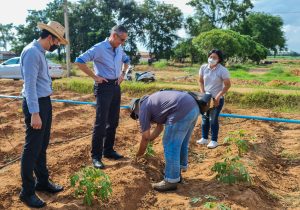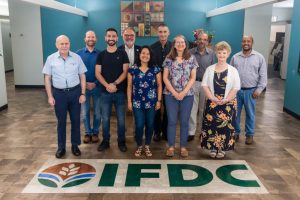Welcome to the second entry of our GFSI Faculty Global Impact blog post series. In this edition, we highlight the work of Dr. Gerrit Hoogenboom, leader of the Decision Support System for Agrotechnology Transfer (DSSAT) initiative. In his words, his research “focuses on the development and application of computer simulation models that predict growth, development, and yield for a variety of crops.”
These prediction models can be applied to manage many different scenarios ranging from breeding and gene-based applications to the impacts of climate change, impact assessment, adaptation, and mitigation strategies.
Creating models for developing countries

Dr. Hoogenboom highlights the importance of using theoretical models to support farmers around the world, especially for the Global South. “In developing countries, it is very difficult to do experimental research. Each country is different, and you can find different soils, different water qualities, and different management practices. So, to have an impact, it might be possible to use models that are capable of responding to environmental conditions, like weather and soil, genetics, differences in crops and varieties, or even if you are cultivating hybrids, and using different crop management techniques. If the models are robust enough via physiologically based biophysical models, then we should be able to take these models to different locations, and they should be able to predict the system fairly well.”
According to Dr. Hoogenboom, the models can predict when flowering occurs, when harvest maturity occurs, and different yield components. To put things in perspective on how important this could be, researchers in developing countries could apply the models to their local conditions, and accurately predict best practices to optimize crop productivity. By using robust biophysical models, the need for (often very expensive) field experimenting would be significantly reduced while increasing local agricultural performance for a fraction of the cost.
DSSAT
What started as a postdoc position to develop a model for dry beans (Phaseolus vulgaris), eventually became the Decision Support System for Agrotechnology Transfer (DSSAT), the current flagship project in Dr. Hoogenboom’s research portfolio. “DSSAT is basically a software system with a crop simulation model under the hood that does predictions as well as have tools to prepare data to run the models. When you run a model, you need to input data, such as local weather, crop types, and others, and then the model predicts outputs. So, you need to analyze the outputs and then ultimately, the idea is to use the outcomes of the model to help farmers make informed decisions.” The DSSAT crop modeling system is one of the most widely used crop modeling systems across the globe.

Applying DSSAT in the Real World
The current emphasis of DSSAT is working with developing countries as many of Dr. Hoogenboom’s projects have been funded in collaboration with international organizations. “We currently have a project funded by the United States Agency for International Development (USAID) called the SERVIR program that is managed through the International Crops Research Institute for the Semi-Arid Tropics (ICRISAT). ICRISAT is a member of the Consortium of International Agricultural Research Centers (CGIAR) with research centers located across the Global South. His role in that project is to look at in-season crop yield prediction, working with local meteorological services. The team developed a tool around DSSAT that allows for spatial yield predictions as the DSSAT crop model itself is a location-specific model. But to look at agricultural productivity across the region, you need to look at spatial applications, so they developed a model that builds on DSSAT called the Regional Agricultural Forecasting Toolbox (CRAFT). This model allows in-season yield forecasting where they input daily weather data up to the day before, and then run the model to predict what the yield will be across an area for the growing season.”
DSSAT and Climate Change
Another area that could benefit from the use of DSSAT is climate change adaptation. The models that Dr. Hoogenboom uses take into consideration local weather conditions and shifts in weather patterns, which are some of the most important variables for farmers, who also happen to be the most affected by climate change. He said, “We’ve had many projects on the potential impact of climate change, adaptation, and mitigation, also working with countries in the Global South. Right now, climate change is probably one of our larger interests. To look at climate change effects on agriculture, first of all, you have to use a Global Climate Model to look at climate projections, and then, you can take those climate projections as inputs into an agricultural model, and the agricultural model can give you predictions for yield to 2050, or 2100. And we know that yields will decrease, but then we can also look at what type of adaptation is required to try to maintain the current yield levels, like heat-resistant or drought-tolerant varieties or different planting days or different inputs.”
Current Challenges

As incredible as technology might be, it is not infallible. Dr. Hoogenboom suggested that some of the current challenges that the space is facing are caused by the trendy nature of issues like climate change and the Sustainable Development Goals (SDGs). That competition and the SDGs can be fickle and variable. He said, “The field right now is incredibly competitive concerning “climate-smart agriculture”, that is the buzzword. A lot of startups, both in the US as well as in the Global South, are trying to develop new apps and push them to growers and I think the field is a little bit overwhelmed. There are too many apps and too many technologies. So it’s very difficult and challenging, even for farmers in the US, but especially in developing countries to decide on which app they should use because there might be an app for when to irrigate, another app for disease management, another app for insect management, another app for market analysis, so you just get overloaded with all the apps. And all of them do different things.”
DSSAT is About Collaboration
As we finished our interview, we asked Dr. Hoogenboom to tell us one thing that he really wants people to know about DSSAT and his current research. “Our research is really about collaboration, whatever my name is associated with it. Especially for modeling the agricultural system, this system is very, very complex, so I don’t have the expertise to look at all areas of the agricultural systems. I’m not an entomologist, I’m not a pathologist, and I’m also not an economist. So, I think it’s very important for us to collaborate with a lot of scientists, not just in the US, but across the globe to really make these models useful here and to ultimately make them useful for smallholder farmers.”
More information about Dr. Hoogenboom’s work can be found here.
 2
2
